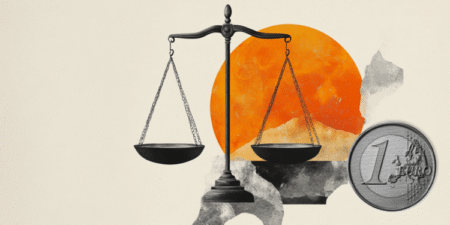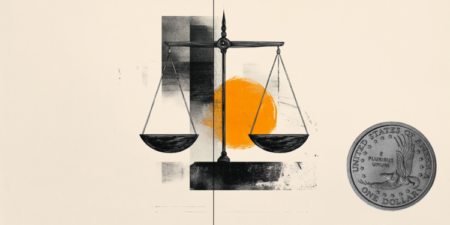- The Indian Rupee loses traction in Thursday’s Asian session.
- Weaker Chinese Yuan and higher crude oil prices weigh on the INR.
- The US weekly Initial Jobless Claims and housing data will be released later on Thursday.
The Indian Rupee (INR) loses ground on Thursday, snapping the five-day winning streak. A weakening Chinese Yuan amid the escalating trade war put pressure on most Asian currencies, including the Indian currency. A recovery in crude oil prices contributes to the INR’s downside as India is the world’s third-largest oil consumer.
Nonetheless, the optimism surrounding Indian stocks could provide some support to the local currency. The Indian benchmark indices have recovered all losses sparked by Trump’s reciprocal tariffs earlier this month. The nation’s big domestic economy is seen as able to withstand a potential global recession better than many peers, who face higher tariffs. Looking ahead, investors await the US Building Permits, Housing Starts, the Philly Fed Manufacturing Index, and the weekly Initial Jobless Claims, which are due later on Thursday. The Indian market will be closed on Good Friday.
Indian Rupee edges lower amid heightened trade tensions
- “The yuan is an anchor currency for Asian markets,” said Sakshi Gupta, principal economist at HDFC Bank. “The RBI may be comfortable with some amount of depreciation if our peers are also depreciating, from a competitiveness perspective.”
- Federal Reserve (Fed) Chair Jerome Powell said on Wednesday that trade tensions risk undermining the Fed’s employment and inflation goals. Powell added that US economic growth appears to be slowing, with consumer spending growing modestly, a rush of imports to avoid tariffs likely to weigh on estimates of Gross Domestic Product (GDP) and sentiment souring.
- The US Retail Sales rose by 1.4% in March, followed by the 0.2% increase seen in February, according to the US Census Bureau on Wednesday. This figure came in better than the estimation of 1.3%.
- Financial markets expect the Fed to resume rate cuts in June and that by year-end the policy rate, currently in the 4.25%-4.50% range, will be a full percentage point lower.
USD/INR’s bearish bias prevails under the 100-day EMA
The Indian Rupee trades in negative territory on the day. The negative view of the USD/INR pair remains intact, with the price holding below the key 100-day Exponential Moving Average (EMA) on the daily timeframe. The path of least resistance is to the downside as the 14-day Relative Strength Index (RSI) stands below the midline near 41.60.
The first downside target to watch is 85.51, the low of April 16. Any follow-through selling below this level could see a drop to 85.20, the low of April 3, followed by 84.95, the low of April 4.
On the other hand, the 85.90-86.00 zone appears to be a tough nut to crack for bulls, representing the 100-day EMA and the psychological level. Sustained trading above the mentioned level could pave the way to 86.61, the high of April 10.
Indian Rupee FAQs
The Indian Rupee (INR) is one of the most sensitive currencies to external factors. The price of Crude Oil (the country is highly dependent on imported Oil), the value of the US Dollar – most trade is conducted in USD – and the level of foreign investment, are all influential. Direct intervention by the Reserve Bank of India (RBI) in FX markets to keep the exchange rate stable, as well as the level of interest rates set by the RBI, are further major influencing factors on the Rupee.
The Reserve Bank of India (RBI) actively intervenes in forex markets to maintain a stable exchange rate, to help facilitate trade. In addition, the RBI tries to maintain the inflation rate at its 4% target by adjusting interest rates. Higher interest rates usually strengthen the Rupee. This is due to the role of the ‘carry trade’ in which investors borrow in countries with lower interest rates so as to place their money in countries’ offering relatively higher interest rates and profit from the difference.
Macroeconomic factors that influence the value of the Rupee include inflation, interest rates, the economic growth rate (GDP), the balance of trade, and inflows from foreign investment. A higher growth rate can lead to more overseas investment, pushing up demand for the Rupee. A less negative balance of trade will eventually lead to a stronger Rupee. Higher interest rates, especially real rates (interest rates less inflation) are also positive for the Rupee. A risk-on environment can lead to greater inflows of Foreign Direct and Indirect Investment (FDI and FII), which also benefit the Rupee.
Higher inflation, particularly, if it is comparatively higher than India’s peers, is generally negative for the currency as it reflects devaluation through oversupply. Inflation also increases the cost of exports, leading to more Rupees being sold to purchase foreign imports, which is Rupee-negative. At the same time, higher inflation usually leads to the Reserve Bank of India (RBI) raising interest rates and this can be positive for the Rupee, due to increased demand from international investors. The opposite effect is true of lower inflation.
Read the full article here
















